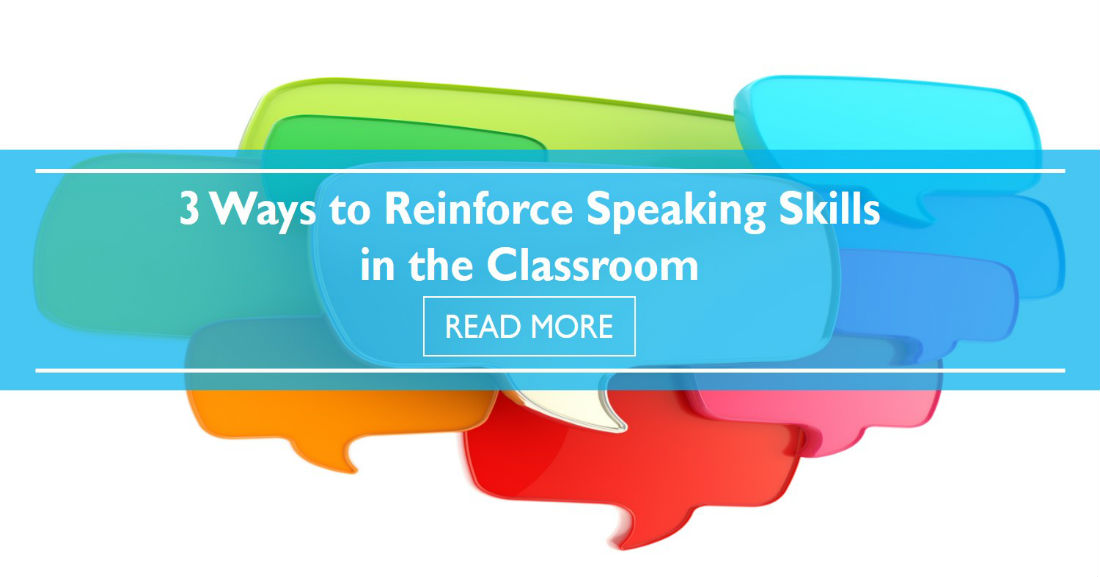3 Ways to Reinforce Speaking Skills in the Classroom


Or how about students who feel that because they can’t speak as fluently as they would like they are not learning? Or maybe you haven’t had these students but you feel pressured to get your class members talking and using English ASAP in order to cover the assigned curriculum or please your administrators. In situations like those, it’s good to remember that language learning isn’t all or nothing. Just because someone can’t speak fluently doesn’t mean they aren’t progressing toward their goals. In tough circumstances where students feel discouraged at their progress or when your supervisors aren’t seeing the results they expect, it’s useful to break language learning down and see that all progress does not necessarily show on the surface.
You probably already know but it is worth a reminder, before anyone can produce language they have to recognize it. Being able to recognize and understand the language we encounter is what is considered receptive language skills. It’s about how much you recognize when you see or hear it. Even native speakers understand far more language than they use when they speak or write. It’s part of the way the brain naturally stores and uses language. Your students will most likely show progress in receptive skills before they show progress in productive skills, which we will talk about next.
Productive language skills are what anyone might think from the name. Productive language skills are about producing language. Where receptive skills tend to focus on reading and listening, productive skills tend to focus on speaking and writing. Students who can use language to express their own thoughts are using productive language skills. But often language learners or those not as familiar with the language learning process think productive skills are the only ones that matter. In fact, language learners cannot have good productive language skills until they first have strong receptive language skills.
Being able to understand what you see on the page is the first step toward fluency in written language. Before you can write in English, you have to be able to read. And not all reading is the same. In reading class we generally focus on three different types of reading skills. The first is skimming. Skimming is reading portions of a text to get a general idea of what it says. Skimming does not mean reading every word nor does it mean understanding and remembering every detail of the text. Skimming is getting the big picture of a written passage. A second reading skill, scanning, is both similar to and different from skimming. Scanning is like skimming in that you do not read all of the words on the page. When you scan you look for specific information, usually in answer to a question. Some questions may be written and formally stated, such as in a reading comprehension exercise. Other questions may be implicit in the reader’s mind and may not even be articulated, but they are still questions none the less. Scanning is also an important skill when it comes to standardized language testing since reading comprehension passages ask for answers to specific questions, and students should be able to find the answers without having to read the entire passage. Finally, reading for detail is an important skill. In this type of reading, students read the entire text, focusing on details as well as main ideas. Reading for detail takes longer than either skimming or scanning, but it is one of the most important skills when it comes to understanding words on the page.
All of these reading skills are receptive language skills since in each case students are being asked to understand what they see on the page and not produce something on their own. These receptive skills are the foundation on which students can build productive language skills, especially those in writing. Those who seek to be strong writers in English would do well to strengthen these reading skills first.
Before someone can speak English, they must first be able to hear it and understand what the other person is saying. Three skills are paramount in receptive language of spoken English: pronunciation, grammar, and vocabulary. In order to understand what you hear, you must first be familiar with the sound system of a language. What sounds are the building blocks to the words students will later produce on their own? Language learners must know what sounds compose a word before they can produce that word on their own. A step up from recognizing individual sound patterns which create words is recognizing grammatical patterns that make up sentences. Sometimes the sequence of words can make a huge difference in meaning, and being able to recognize certain grammar rules in use is a keystone of having good receptive language skills. Underscoring it all, both in listening and reading, is vocabulary. Anyone who understands what they read or what they hear will be dependent on knowing the meaning of the words others are using.
Productive language skills, though they are often how someone judges overall language knowledge, are actually secondary. They always follow receptive skills. For the most part, productive skills manifest in speaking and writing a language. Productive skills in speaking include pronunciation and discourse skills as well as vocabulary. How well can a speaker say the words he or she knows? Being able to produce the sound patterns that make up words in English is paramount in having good productive skills. That’s not to say someone can’t have an accent, but they do need to be understandable. When accent inhibits comprehension on the part of a listener, the speaker shows a lack of productive skills. Discourse skills also fall into the category of productive language skills. How easily does a person speak? Can they hold their own in a conversation? And once again vocabulary comes into play. A person’s receptive vocabulary is always greater than their productive vocabulary, so students should not be surprised when they cannot use every word that they recognize in English.
Grammar and vocabulary also play a big part in writing skills, and even though both are important for receptive language use they are also important for productive language use. In addition, spelling is a piece of the productive language puzzle. Without accurate spelling, grammar and vocabulary are meaningless since they cannot be understood by readers. In addition to these, adhering to writing standards is a productive language skill. Not all cultures and languages have the same expectations when it comes to how something should be written. It is therefore important for English learners to know what the expectations are and to adhere to them in order to have good productive language skills.
These productive skills are the second layer of language learning and should not be the only measure of how well someone’s language learning is progressing even though they are more obvious than receptive skills. When anyone is putting pressure on students to perform, helping them understand specific receptive and productive language skills can give them a better picture of what language learning is actually going on.
Sometimes productive skills get all the glory. They are the only measures some people, students and educators, use to determine how well someone is learning English. We need to make our students aware that productive skills are only a part of the puzzle. That before they can excel at speaking and writing, they must first become proficient at receptive skills. When these are strong the brain will naturally transfer them to productive skills, but it is worth mentioning that receptive skills are always greater than productive skills, both in second language learners as well as first language learners. So if your students are feeling discouraged or you are getting pressure from the upper ups, point out that not all skills in language learning are displayed in speaking and writing and that how much a student understands is just as important as how much he or she can produce.